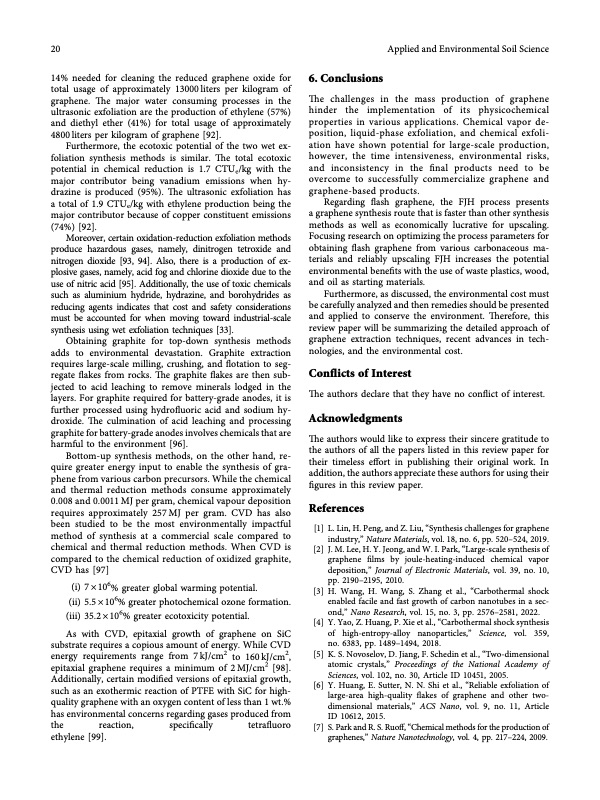
PDF Publication Title:
Text from PDF Page: 020
20 Applied and Environmental Soil Science 14% needed for cleaning the reduced graphene oxide for total usage of approximately 13000liters per kilogram of graphene. Te major water consuming processes in the ultrasonic exfoliation are the production of ethylene (57%) and diethyl ether (41%) for total usage of approximately 4800 liters per kilogram of graphene [92]. Furthermore, the ecotoxic potential of the two wet ex- foliation synthesis methods is similar. Te total ecotoxic potential in chemical reduction is 1.7 CTUe/kg with the major contributor being vanadium emissions when hy- drazine is produced (95%). Te ultrasonic exfoliation has a total of 1.9 CTUe/kg with ethylene production being the major contributor because of copper constituent emissions (74%) [92]. Moreover, certain oxidation-reduction exfoliation methods produce hazardous gases, namely, dinitrogen tetroxide and nitrogen dioxide [93, 94]. Also, there is a production of ex- plosive gases, namely, acid fog and chlorine dioxide due to the use of nitric acid [95]. Additionally, the use of toxic chemicals such as aluminium hydride, hydrazine, and borohydrides as reducing agents indicates that cost and safety considerations must be accounted for when moving toward industrial-scale synthesis using wet exfoliation techniques [33]. Obtaining graphite for top-down synthesis methods adds to environmental devastation. Graphite extraction requires large-scale milling, crushing, and fotation to seg- regate fakes from rocks. Te graphite fakes are then sub- jected to acid leaching to remove minerals lodged in the layers. For graphite required for battery-grade anodes, it is further processed using hydrofuoric acid and sodium hy- droxide. Te culmination of acid leaching and processing graphite for battery-grade anodes involves chemicals that are harmful to the environment [96]. Bottom-up synthesis methods, on the other hand, re- quire greater energy input to enable the synthesis of gra- phene from various carbon precursors. While the chemical and thermal reduction methods consume approximately 0.008 and 0.0011 MJ per gram, chemical vapour deposition requires approximately 257MJ per gram. CVD has also been studied to be the most environmentally impactful method of synthesis at a commercial scale compared to chemical and thermal reduction methods. When CVD is compared to the chemical reduction of oxidized graphite, CVD has [97] (i) 7×106% greater global warming potential. (ii) 5.5 × 106% greater photochemical ozone formation. (iii) 35.2×106% greater ecotoxicity potential. As with CVD, epitaxial growth of graphene on SiC substrate requires a copious amount of energy. While CVD energy requirements range from 7 kJ/cm2 to 160 kJ/cm2, epitaxial graphene requires a minimum of 2 MJ/cm2 [98]. Additionally, certain modifed versions of epitaxial growth, such as an exothermic reaction of PTFE with SiC for high- quality graphene with an oxygen content of less than 1 wt.% has environmental concerns regarding gases produced from the reaction, specifcally tetrafuoro ethylene [99]. 6. Conclusions Te challenges in the mass production of graphene hinder the implementation of its physicochemical properties in various applications. Chemical vapor de- position, liquid-phase exfoliation, and chemical exfoli- ation have shown potential for large-scale production, however, the time intensiveness, environmental risks, and inconsistency in the fnal products need to be overcome to successfully commercialize graphene and graphene-based products. Regarding fash graphene, the FJH process presents a graphene synthesis route that is faster than other synthesis methods as well as economically lucrative for upscaling. Focusing research on optimizing the process parameters for obtaining fash graphene from various carbonaceous ma- terials and reliably upscaling FJH increases the potential environmental benefts with the use of waste plastics, wood, and oil as starting materials. Furthermore, as discussed, the environmental cost must be carefully analyzed and then remedies should be presented and applied to conserve the environment. Terefore, this review paper will be summarizing the detailed approach of graphene extraction techniques, recent advances in tech- nologies, and the environmental cost. Conflicts of Interest Te authors declare that they have no confict of interest. Acknowledgments Te authors would like to express their sincere gratitude to the authors of all the papers listed in this review paper for their timeless efort in publishing their original work. In addition, the authors appreciate these authors for using their fgures in this review paper. References [1] L. Lin, H. Peng, and Z. Liu, “Synthesis challenges for graphene industry,” Nature Materials, vol. 18, no. 6, pp. 520–524, 2019. [2] J.M.Lee,H.Y.Jeong,andW.I.Park,“Large-scalesynthesisof graphene flms by joule-heating-induced chemical vapor deposition,” Journal of Electronic Materials, vol. 39, no. 10, pp. 2190–2195, 2010. [3] H. Wang, H. Wang, S. Zhang et al., “Carbothermal shock enabled facile and fast growth of carbon nanotubes in a sec- ond,” Nano Research, vol. 15, no. 3, pp. 2576–2581, 2022. [4] Y. Yao, Z. Huang, P. Xie et al., “Carbothermal shock synthesis of high-entropy-alloy nanoparticles,” Science, vol. 359, no. 6383, pp. 1489–1494, 2018. [5] K. S. Novoselov, D. Jiang, F. Schedin et al., “Two-dimensional atomic crystals,” Proceedings of the National Academy of Sciences, vol. 102, no. 30, Article ID 10451, 2005. [6] Y. Huang, E. Sutter, N. N. Shi et al., “Reliable exfoliation of large-area high-quality fakes of graphene and other two- dimensional materials,” ACS Nano, vol. 9, no. 11, Article ID 10612, 2015. [7] S.ParkandR.S.Ruof,“Chemicalmethodsfortheproductionof graphenes,” Nature Nanotechnology, vol. 4, pp. 217–224, 2009.PDF Image | State-of-the-Art Graphene Synthesis Methods

PDF Search Title:
State-of-the-Art Graphene Synthesis MethodsOriginal File Name Searched:
8475504.pdfDIY PDF Search: Google It | Yahoo | Bing
Salgenx Redox Flow Battery Technology: Power up your energy storage game with Salgenx Salt Water Battery. With its advanced technology, the flow battery provides reliable, scalable, and sustainable energy storage for utility-scale projects. Upgrade to a Salgenx flow battery today and take control of your energy future.
| CONTACT TEL: 608-238-6001 Email: greg@infinityturbine.com | RSS | AMP |